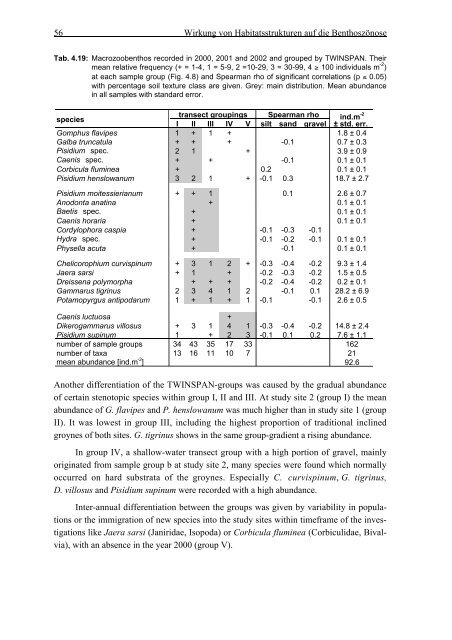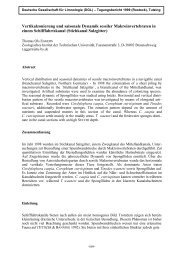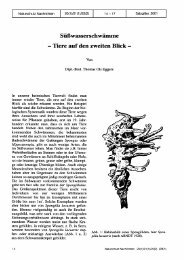Archivserver der Deutschen Nationalbibliothek
Archivserver der Deutschen Nationalbibliothek
Archivserver der Deutschen Nationalbibliothek
Sie wollen auch ein ePaper? Erhöhen Sie die Reichweite Ihrer Titel.
YUMPU macht aus Druck-PDFs automatisch weboptimierte ePaper, die Google liebt.
56 Wirkung von Habitatsstrukturen auf die Benthoszönose<br />
Tab. 4.19: Macrozoobenthos recorded in 2000, 2001 and 2002 and grouped by TWINSPAN. Their<br />
mean relative frequency (+ = 1-4, 1 = 5-9, 2 =10-29, 3 = 30-99, 4 ≥ 100 individuals m -2 )<br />
at each sample group (Fig. 4.8) and Spearman rho of significant correlations (p ≤ 0.05)<br />
with percentage soil texture class are given. Grey: main distribution. Mean abundance<br />
in all samples with standard error.<br />
species<br />
transect groupings Spearman rho ind.m -2<br />
I II III IV V silt sand gravel ± std. err.<br />
Gomphus flavipes 1 + 1 + 1.8 ± 0.4<br />
Galba truncatula + + + -0.1 0.7 ± 0.3<br />
Pisidium spec. 2 1 + 3.9 ± 0.9<br />
Caenis spec. + + -0.1 0.1 ± 0.1<br />
Corbicula fluminea + 0.2 0.1 ± 0.1<br />
Pisidium henslowanum 3 2 1 + -0.1 0.3 18.7 ± 2.7<br />
Pisidium moitessierianum + + 1 0.1 2.6 ± 0.7<br />
Anodonta anatina + 0.1 ± 0.1<br />
Baetis spec. + 0.1 ± 0.1<br />
Caenis horaria + 0.1 ± 0.1<br />
Cordylophora caspia + -0.1 -0.3 -0.1<br />
Hydra spec. + -0.1 -0.2 -0.1 0.1 ± 0.1<br />
Physella acuta + -0.1 0.1 ± 0.1<br />
Chelicorophium curvispinum + 3 1 2 + -0.3 -0.4 -0.2 9.3 ± 1.4<br />
Jaera sarsi + 1 + -0.2 -0.3 -0.2 1.5 ± 0.5<br />
Dreissena polymorpha + + + -0.2 -0.4 -0.2 0.2 ± 0.1<br />
Gammarus tigrinus 2 3 4 1 2 -0.1 0.1 28.2 ± 6.9<br />
Potamopyrgus antipodarum 1 + 1 + 1 -0.1 -0.1 2.6 ± 0.5<br />
Caenis luctuosa +<br />
Dikerogammarus villosus + 3 1 4 1 -0.3 -0.4 -0.2 14.8 ± 2.4<br />
Pisidium supinum 1 + 2 3 -0.1 0.1 0.2 7.6 ± 1.1<br />
number of sample groups 34 43 35 17 33 162<br />
number of taxa 13 16 11 10 7 21<br />
mean abundance [ind.m -2 ] 92.6<br />
Another differentiation of the TWINSPAN-groups was caused by the gradual abundance<br />
of certain stenotopic species within group I, II and III. At study site 2 (group I) the mean<br />
abundance of G. flavipes and P. henslowanum was much higher than in study site 1 (group<br />
II). It was lowest in group III, including the highest proportion of traditional inclined<br />
groynes of both sites. G. tigrinus shows in the same group-gradient a rising abundance.<br />
In group IV, a shallow-water transect group with a high portion of gravel, mainly<br />
originated from sample group b at study site 2, many species were found which normally<br />
occurred on hard substrata of the groynes. Especially C. curvispinum, G. tigrinus,<br />
D. villosus and Pisidium supinum were recorded with a high abundance.<br />
Inter-annual differentiation between the groups was given by variability in populations<br />
or the immigration of new species into the study sites within timeframe of the investigations<br />
like Jaera sarsi (Janiridae, Isopoda) or Corbicula fluminea (Corbiculidae, Bivalvia),<br />
with an absence in the year 2000 (group V).






